From Hexham I faced northward and followed the North Tyne up through a very picturesque and romantic valley, thickly wooded and studded with baronial mansions, parks, castles and residences of gentry, with comfortable farm-houses looking sunny and cheerful on the green hill slopes and on the quiet banks of the river. I saw fields of wheat quite green, looking as if they needed another month’s sun to fit them for harvesting. Lodged in a little village about eight miles from Hexham. The next day walked on to the little hamlet of Fallstones, a distance of about twenty miles. As I ascended the valley, the scene changed rapidly. The river dwindled to a narrow stream. The hills that walled it in on either side grew higher and balder, and the clouds lay cold and dank upon their bleak and sullen brows. The hamlets edged in here and there grew thinner, smaller and shabbier. The road was barred and gated about once in a mile, to keep cattle and sheep from wandering; there being no fences nor hedges running parallel with it. In a word, the premonitory symptoms of a bare border-land thickened at every turn.
Another day brought me into the midst of a wild region, which might be called No-man’s-land; although most of it belongs to the Duke of Northumberland. It is all in the solitary grandeur of heather-haired hills, which tinge, with their purple flush, the huge, black-winged clouds that alight upon them. Only here and there a shepherd’s cottage is to be seen half way up the heights, or sheltering itself in a clump of trees in glen or gorge, like a benighted traveller bivouacking for a night in a desert. Sheep, of the Cheviot breed mostly, are nearly the sole inhabitants and industrials of this mountainous waste. They climb to the highest peaks and bring down the white wealth of their wool to man. It was pleasant to see them like walking mites, flecking the dark brows of the mountains. They made a picture; they made a tableau vivant of the same illustration as Landseer’s lamb looking into the grass-covered cannon’s mouth.
This is the Border-land! Here the fiercest antagonisms of hostile nationalities met in deadly conflict. Fire and blood, rapine and wrath blackened and reddened and ravaged for centuries across this bleak territory. Robber-chieftains and knighted free-booters carried on their guerilla raids backward and forward, under the counterfeited banner of patriotism. Scotch and English armies led by kings marched and counter-marched over this sombre boundary. Never before was there one apparently more insoluble as a barrier between two peoples. Never before in Christendom was there one that required a longer space of time to melt. Never before did the fusing of two nationalities encounter more fierce and prolonged opposition. Did ever patriotism pour out a swifter and deeper tide of chivalrous sentiment against merging one in another?—against uniting two thrones and two peoples in one? Did patriotism ever fight bloodier battles to prevent such a union, or cling to local sovereignty with a more desperate hold?




